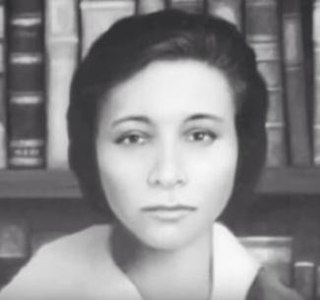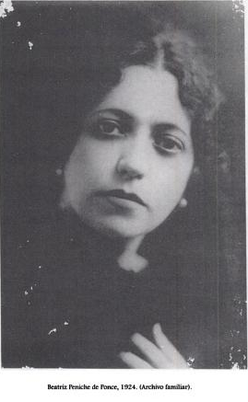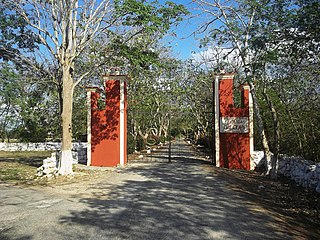
Elvia Carrillo Puerto was a Mexican socialist politician and feminist activist. Carrillo had been married by the age of 13 and widowed by 21. She founded some of Mexico's first feminist organizations, including the League of Rita Cetina Gutiérrez in 1919. In 1923, Carrillo became Mexico's first woman state deputy when she was elected to the Congress of Yucatán. Due to Carrillo's contributions to Mexican government and history, she was officially honored as a "Veteran of the Revolution". Carrillo's tireless dedication to the revolution and women's movement earned her the nickname "The Red Nun".

The fourth federal electoral district of Yucatán(Distrito electoral federal 04 de Yucatán) is one of the 300 electoral districts into which Mexico is divided for elections to the federal Chamber of Deputies and one of six such districts in the state of Yucatán.

Beltrán de Cetina y del Castillo was one of the original conquistadors and founders of Mérida in the modern Mexican state of Yucatán. His siblings included: Renaissance poet Gutierre de Cetina; Ana Andrea del Castillo, self-described conquistadora and wife of Francisco de Montejo the Younger; and Gregorio de Cetina, also a conqueror of Yucatán.

Yaxcabá is a municipality in the Mexican state of Yucatán containing (1079 km2) of land and located roughly 80 km northeast of the city of Mérida.

María Rosa Torre González was born in the state of Yucatán, Mexico. She was the first woman in Mexico to hold an elected office.

Beatriz Peniche Barrera was a writer, teacher and Mexican feminist. She was a leader of the Socialist Party of the Southeast and one of the first three women elected to a legislative body in Mexico. She collaborated with writers and poets from Mexico and Cuba, publishing numerous works.

Raquel Dzib Cicero (1882-1949) was a teacher and Mexican feminist. She was an early member of the Socialist Party of the Southeast and one of the first three women elected to a legislative body in Mexico. She taught for over fifty years and was still teaching at the time of her death.

Consuelo Zavala Castillo (1874-1956) was a Mexican feminist, teacher, and founder of one of the first secular private schools in Mérida, Mexico. She is credited with establishing the first kindergarten to utilize the Froebel method in Mérida. She was the organizer of the First Feminist Congress in Mexico, authorized by state governor Salvador Alvarado.

Leonarda Gómez Blanco was a Mexican teacher and early member of the Socialist Party of the Southeast. Served as the head of the Cultural Missions Program and Director of Education in both Campeche and Tlaxcala.
Félix Ramos y Duarte (1848–1924) was a Cuban educator and writer, who was exiled from Cuba in 1868. He moved to Yucatán, Mexico and later lived in Veracruz and Mexico City. He compiled the first dictionary of terms that were specifically "Mexican Spanish". Ramos returned to Cuba after it gained independence from Spain. He taught briefly and then served as President of the Teacher Examination Board. He published many textbooks and educational articles.
Antonia Jiménez Trava was a Mexican attorney. She was the first female law graduate from UADY, and the first woman appointed to public office in Yucatán. She served as the first Director of the Civil Registry, the first President of the Electoral Institute of the State, and the first President of the Judiciary. She was a feminist, writing her dissertation on the legality of denying women the vote and when appointed to run the Civil Registry, she eliminated discriminatory texts from the marriage ceremony.

Hacienda Dzibikak is located in the Umán Municipality within the town of Umán in the state of Yucatán in southeastern Mexico. It is one of the properties that arose during the nineteenth century henequen boom.

Hacienda Kancabchén is located in the Baca Municipality in the state of Yucatán in southeastern Mexico. It is one of the properties that arose during the nineteenth century henequen boom. Kancabchén is a word from the Mayan language meaning 'the well of the red ground'. The property is located 22 km from Mérida to the east of the Periférico off Carretera Mérida-Motul south of Baca.

Hacienda San Ildefonso Teya is located in the Kanasín Municipality in the state of Yucatán in southeastern Mexico. During the seventeenth century it was one of the largest and most profitable cattle ranches in Yucatán. It was converted to agriculture and during the nineteenth century was part of the henequen boom. The hacienda has been restored and converted into a hotel, restaurant and tourist center.

Hacienda San Antonio Tahdzibichén is located in the Mérida Municipality in the state of Yucatán in southeastern Mexico. It is one of the properties that arose during the nineteenth century henequen boom. It is part of the Cuxtal Ecological Reserve which was set aside in 1993 to protect both the man-made and natural history of the reserve area of Mérida.

Anabel Gutiérrez Aicua was a Mexican actress and comedian. Her most memorable works included her participation in the film School for Tramps (1955), as well as her appearances on the program Chespirito (1970), playing the character of Doña Espotaverderona in some sketches.

Hacienda Katanchel is located in the Tixkokob Municipality in the state of Yucatán in southeastern Mexico. It is one of the properties that arose during the nineteenth century henequen boom. In the late 1990s, the property was restored and converted into a nature reserve and a resort. Local residents can attend seminars at the hacienda laboratory to learn about the local flora and fauna.
Cristina Farfán was an educator and writer who promoted women's education and was involved in the emergence of the first wave feminist movement in Mexico. She was one of the founders of women's literary journalism in Mexico.

The First Feminist Congress of Yucatán was a gathering of Mexican feminists that happened in 1916. The delegates gathered at the José Peón Contreras Theater in Mérida, Yucatán, Mexico from January 13 to 16. It was held under the auspices of the Yucatecan government. The Mexican government and historians largely consider it the first of its kind in the country. It was the second to be held in all of Latin America and the Caribbean, the first held in Argentina in 1910.

La Siempreviva was a Mexican literary society founded in 1870 by Rita Cetina Gutiérrez, Gertrudis Tenorio Zavala, and Cristina Farfán in Mérida, Yucatán. Named for the liveforever plant, the society aimed to promote fine arts, charity, and education for women in the state. As part of its mission, La Siempreviva founded a periodical and school, both of which were also called La Siempreviva.

















